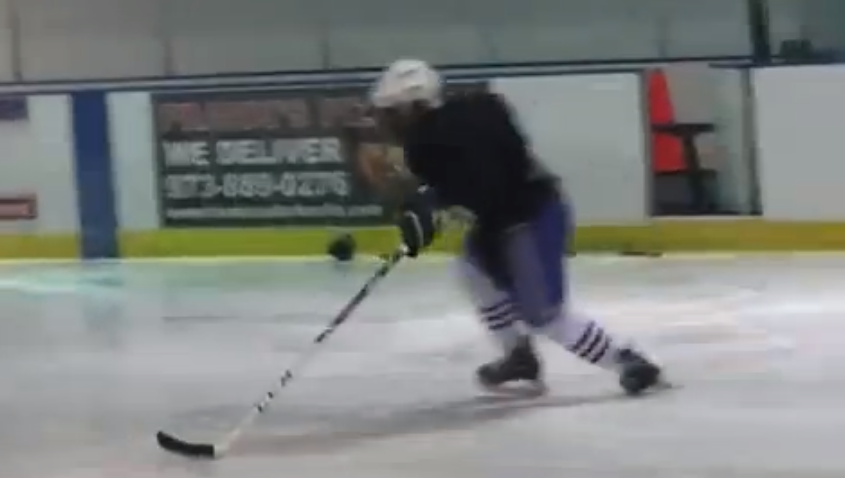A couple weeks ago I got an email from a youth player asking me to analyze his skating stride. He felt, and I agree, that he was leaving some “free speed” on the table by now optimizing his stride pattern.
You can watch the videos of his skating below:
At first glance, there are a few minor adjustments I’d recommend to him that are extremely common for young players:
1) Get a slightly deeper skating stance.
He’s not as “upright” of a skater as some players, but I think he may have another inch or so of depth left to achieve his optimal skating position. Moving into a slightly deeper skating position will increase his stride length, and therefore the amount of force he can put into the ice to propel himself forward with each stride
2) Recover the stride leg fully under the body
Again, he does a pretty good job here, but there’s a little room for improvement. Recovering the stride leg completely under the body does two things: It increases the stride length on the next stride by giving it a starting position a little closer to the body (e.g. adding stride length at the initiation of the stride, not at the end as getting a deeper stance would help achieve), and it minimize excessive friction of the skate blade on the ice of the stance leg by moving the skate off of the inside edge a bit. The more players ride their inside edges on their stance leg, the more “drag” there is on the ice, slowing the player down a little with each stride.
3) Pushing “out” instead of “up” on the starts
If you watch a lot of the starts, the player’s body pushes “up” before actually moving anywhere. If the goal is to move horizontally and not vertically (you’re not racing toward the ceiling), he should focus more on leaning in toward the direction he wants to move and pushing the ice back and away from him. In cuing similar movements off the ice, we sometimes use the phrase “low ceiling” to help players visualize that the goal is to move laterally without lifting their hips up excessively.
These are all important things to work on, and I think with a little practice he’ll be able to make significant improvements in these areas. With that said, the two major areas I think he has the room for the most significant improvements are:
1) Adopting a more “diagonal” than “lateral” arm swing
If you look at a lot of the forward skating, the arm swing is more side to side, than front to back. I refer to this as the “Carlton Dance” (See 1:35 below)
You’ll notice that there is a lot of lateral sway in the players skating stride. There are a lot of reasons why this may be the case, but an excessively lateral arm swing will certainly carry the body’s momentum in more of a side-to-side pattern, wasting energy and slowing the player down.
2) “Pushing under” with the cross-under leg
This may be the most overlooked skating cue in “curvilinear” (e.g. not straight forward or backward) skating. If you look at the cross-over patterns, it looks like the emphasis is on stepping over with the cross-over leg. There’s A LOT of power to be gained by emphasizing the “push under” of the other leg.

In the videos, the cross-under leg doesn’t ever achieve full extension, which is a common sign that it’s not being used as a driver. In training this, sometimes it’s better to slow things down a bit and just focusing on pushing under as forcefully as possible while maintaining a good body position. Once the player has a good understanding of this motion, they can progressively pick up speed.
As I mentioned, these are all pretty common adjustments that players at every level can benefit from working on. I’d consider everything above “the basics”, meaning they’re the most important things to master. Even the “elite” players can benefit from checking in periodically to make sure they’re still doing these things and haven’t progressively developed poor habits over time.
In a follow-up post, I’ll show you what I look for in my off-ice assessment and how limitations off the ice can help explain a lot of what we see as strides flaws on the ice.
In the meantime, if you’re interested in more information about optimal stride patterns and off-ice training strategies to maximize skating speed, check out Breakaway Hockey Speed.
To your success,
Kevin Neeld
HockeyTransformation.com
OptimizingMovement.com
UltimateHockeyTraining.com
Please enter your first name and email below to sign up for my FREE Athletic Development and Hockey Training Newsletter!
“Kevin Neeld is one of the top 5-6 strength and conditioning coaches in the ice hockey world.”
– Mike Boyle, Head S&C Coach, US Women’s Olympic Team
“…if you want to be the best, Kevin is the one you have to train with”
– Brijesh Patel, Head S&C Coach, Quinnipiac University